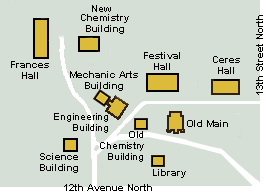North Dakota Agricultural College (NDSU)
 NDAC campus in 1909
NDAC campus in 1909
In January of 1890, a bill was introduced to the North Dakota state legislature which called for the establishment and operation of the North Dakota Agricultural College and Experiment Station at Fargo. The bill passed and was approved by the governor on March 8, 1890. The first meeting of the Board of Trustees was on May 1, 1890. The approval of the first budget and the confirmation of the president (Horace E. Stockbridge) and the first three faculty (Henry L. Bolley, Edwin F. Ladd, and Clare Bailey Waldron) on October 15, 1890, mark the beginning of North Dakota Agricultural College (NDAC). On January 3, 1892, NDAC opened with 123 students enrolled for the term. In the 1910-1911 school year, there were about 225 students enrolled in the collegiate curricula and another 800 enrolled in the vocational curricula, the high school curricula, and winter short courses.
NDAC was located at the northwestern edge of Fargo at the corner of 12th Avenue and 13th Street (now University Drive). In the panorama above, in which the viewer is facing northeast, the buildings (from left to right) are the Engineering Building, the Chemistry Building, Old Main [the first building on campus], and the library. To learn more about the buildings in the panorama above, simply point and click on the building. The reader is encouraged to learn more about the history of campus buildings by visiting a marvelous site maintained by NDSU. Thanks to Victoria Santiago for her enhancement of the image above.

The map on the right shows the location of the nine NDAC buildings that had been erected by 1915. View each building by clicking on that building--except for the Mechanic Arts Building for which no postcard image has been found. A few other interesting views of the college can be found here. An aerial view can be seen here. Some of the agricultural buildings can be seen here.
On December 8, 1960, NDAC succeeded in a four decade struggle to change its name--it became North Dakota State University, a name that reflected its multidisciplinary colleges.
